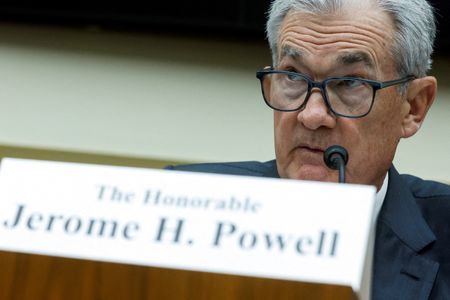(Reuters) – Investors are increasingly of a mind that the U.S. Federal Reserve has delivered the final installment of what has been most aggressive policy-tightening cycle in four decades, but central bank officials caution it is still too soon to make that call.
Last week’s quarter-point interest-rate hike brought the Fed’s policy rate to a range of 5.25% to 5.50% from near zero 16 months ago. The rate hikes are aimed at bringing what had been the highest inflation since the 1980s back down to their target of 2%.
They have made notable progress, with the Fed’s preferred inflation gauge – the Personal Consumption Expenditures price index (PCE) – decelerating in June to 3% from its peak rate of 7% last summer.
Fed officials are not ready to declare victory, though. Central bank Chair Jerome Powell said last week the pieces of the low inflation “puzzle” may be aligning, but he doesn’t trust it yet.
An eight-week gap until the next meeting on Sept. 19-20 will feature two months worth of several critical pieces of data on employment, growth and inflation, the “totality” of which he said will guide the decision to stand pat here or push rates higher still.
Here is a guide to some of the numbers shaping the policy debate:
EMPLOYMENT (Released on Aug. 4, next release on Sept. 1):
The U.S. economy in July added 187,000 jobs, fewer than economists expected and fresh evidence of more of the kind of labor market cooling that Fed officials say is needed to ease inflation pressures.
Hourly wage gains, however, remained strong, holding at 4.4% for a fourth straight month, and the unemployment rate ticked down to 3.5%. Both are signs of labor market tightness that may cast doubt on whether the Fed really has done enough.
The mixed results throw the question of labor market strength forward to the next employment report, due to arrive a couple weeks before the next rate-setting meeting.
JOB OPENINGS: (Released on Aug. 1, next release on Aug. 29)
Powell keeps a close eye on the Labor Department’s Job Openings and Labor Turnover Survey, or JOLTS, to derive what has become a key metric of the imbalance between labor supply and demand – the number of job openings for each job seeker. During the pandemic there were nearly two jobs for every available worker. That ratio has dropped as the Fed’s rate hikes have slowed labor market demand. In June, it was unchanged from the prior month at about 1.6-to-1, matching its lowest level since November 2021.
INFLATION (Released on July 28, next release on Aug. 10):
Headline PCE skidded to a two-year low in June but of even greater note was that the rate stripped of food and energy costs dropped more than expected to its lowest since September 2021 at 4.1%. Fed officials see that as a better indicator of underlying inflation trends and, worryingly for them, until June it had been stuck at about 4.6% since last December.
The break lower in June helped to reinforce the earlier CPI reading, and a number of economists expect continued steady progress from here. If realized, that could undercut arguments for more hikes, and may shift the Fed’s relentlessly hawkish tone.
Fed officials will see one more PCE report and two CPI prints before they next sit down next month.
RETAIL SALES (Released on July 18, next release on Aug. 15):
Retail sales rose less than expected in June, increasing just 0.2%. But a separate measure known as “core” retail sales, which better reflects underlying economic growth, posted a strong 0.6% gain. The overall slow pace of increase may indicate the start of a pullback by consumers, something that the Fed has been anticipating and, through its rate hikes, trying to encourage.
BANK DATA: Released every Thursday and Friday
To some degree the Fed wants credit to become more expensive and less available. That’s how increases in its policy rate influence economic activity. But recent bank failures threatened both unwanted broader stress in the industry and a worse-than-anticipated credit crunch. Weekly data on bank lending to customers show loan growth is slowing. Borrowing by banks from the Fed, meanwhile, remains elevated but relatively stable on a week-to-week basis.
(Reporting By Dan Burns and Howard Schneider; Editing by Andrea Ricci and Louise Heavens)





